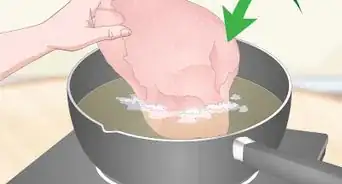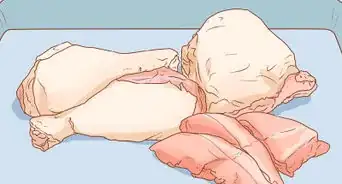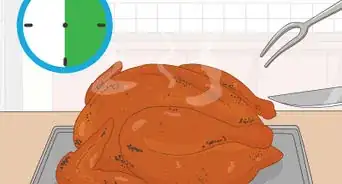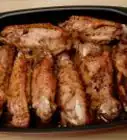This article was co-authored by wikiHow Staff. Our trained team of editors and researchers validate articles for accuracy and comprehensiveness. wikiHow's Content Management Team carefully monitors the work from our editorial staff to ensure that each article is backed by trusted research and meets our high quality standards.
The wikiHow Video Team also followed the article's instructions and verified that they work.
This article has been viewed 43,927 times.
Learn more...
Meat spoils very quickly if not consumed by the use-by date. But turning meat into jerky by drying it out allows you to preserve meat at room temperature for up to a month. While red meats like venison and beef are most commonly used for jerky, turkey is a unique, healthy, and delicious substitute when you want to make your own jerky.
Ingredients
- 1-½ lb white-meat turkey breast
- 1/3 cup soy sauce
- ¼ cup Worcestershire sauce
- 1 tb liquid smoke
- 2 tsp dark brown sugar, firmly packed.
- 1 tsp kosher salt
- ½ tbs. each red pepper flakes, black pepper, garlic powder, onion powder, if desired
Steps
Making "Classic" Turkey Jerky
-
1Trim and discard the fat from the meat. Fat will go rancid quickly if you are not careful, and it does not dry out well. Use a sharp kitchen knife to clean off the turkey and remove the shiny skin and bright white fat.
-
2Freeze the 1-½lbs turkey breasts until firm. Cover the turkey and freeze it until it is hard. This makes it hard and easier to cut into thin strips Two hours should be more than enough.[1]Advertisement
-
3Slice the turkey into long, ¼ inch strips. Try not to have any strips thicker than 1/4 inch, but even thinner is fine if possible. You should try and keep the slices the same width so they all dry out at the same speed. If you are having trouble, let them thaw out for 20-30 minutes until they are softer and use the sharpest knife you have.
- Tuck your fingers into your hand and use the knuckles on your non-cutting hand to guide the knife. This way, if the knife slips, you cannot take off a finger.
- An electric knife, used for cutting tough meat and bone is often the easiest way to smoothly cut through frozen turkey evenly.
- Cut parallel to the grain, which are the strands of meat running up and down the turkey.
-
4Mix together your marinade ingredients in a large zip-lock bag. Combine the 1/3 cup soy, ¼ cup Worcestershire, 2 tsp brown sugar, ½ tbs. spices (red pepper, black pepper, garlic and onion powder, cumin, as desired), 1 tsp. salt, 1tbs. liquid smoke, in a bag and shake it gently to make sure everything is well mixed.
-
5Add the turkey to the marinade and refrigerate overnight. Mix the turkey in the bag, using your fingers to lightly massage the marinade all around the turkey. Letting the turkey soak in the marinade overnight gives it flavor and makes the meat more tender, making it easier to turn into jerky.
- Press the air out of the bag before putting it in the fridge.
-
6Remove the turkey from the marinade and pat it dry. Remove excess marinade so that the turkey is mostly dry.
- If you are worried about food-borne bacteria you can boil the turkey in the marinade before continuing. Simply add it to a skillet and boil it for 5 minutes before cooling, removing, and patting dry. This will also lower the time needed to dry the jerky in the oven.[2]
-
7Lay the turkey on the rack of a dehydrator at 140˚F if you have one. Dehydrators will make perfect jerky every time, and are built to evenly dry out the meat. Leave the meat in the dehydrator for 10-12 hours, or until it is your desired texture.[3]
- If you do not have a dehydrator, you can use your oven as well. The principles, low heat, letting moisture escape, will be the exact same.
-
8Place the turkey strips on a wire rack in the oven. The pieces should not overlap, but they can be close together. If you are willing to clean your oven later, you can put them directly on the oven racks, or you can place a pan underneath a wire rack.
-
9Turn the oven to 175˚F and prop the door open with a wooden spoon. You need the door to be open in order for the turkey's moisture to escape. Some older ovens may have trouble keeping this temperature, so use an oven thermometer to make sure the heat stays consistent.[4]
- Some recipes call for a 150˚F oven and others a 200˚F oven. Any temperature in this range is acceptable, but it will affect how long it takes to dry.
-
10Check your jerky after the first 3 hours, then every hour after that. The jerky is done when you can bend it without breaking it. The skin will crack but still bend in your hands. That said, the texture is largely up to you, so dry it until your liking as long as it is hard and thus fully "cooked."
- Depending on the oven and the thickness of the jerky, this may take all night.
-
11Remove the jerky, pat it dry, then store in sealed, dry place for up to a month. Jerky does not need to be refrigerated, making it a great backpacking or traveling food, and it will last for a long time in dark and well-sealed container.
Variations
-
1Try out sesame-soy jerky. This Asian-inspired jerky is a sharp departure from the smokey, classic jerky frequently found in stores, and it is delicious. The following recipe is for 3 lbs of meat instead of one. Simply substitute the following ingredients for your normal marinade and keep the rest of your steps the same:
- ¼ cup sesame oil
- ½ cup soy sauce
- ¼ cup brown sugar
- 2 tablespoons sesame seeds
- 2 teaspoons ground pepper
- ½ teaspoons powdered ginger[5]
-
2Mix things up with a cola inspired marinade. While it requires a little extra work, this cola marinade from The Food Network has a light, smokey sweetness that goes great on the turkey. Heat up 1 cup cola, 1/3 cup soy sauce, 1/3 cup unseasoned rice vinegar, and ¼ cup honey in a saucepan for 10-12 minutes on medium heat, then let it cool. Add any combinations of the following spices, then add the mixture in place of your normal marinade.
- Salt, to taste.
- 1 teaspoon paprika, black pepper, onion powder, garlic powder, and/or ground chipotle[6]
-
3Add Sriracha, crushed red pepper, or Tabasco sauce to give your jerky a kick. Looking for something a little spicy? Adding a tablespoon of the following ingredients will give your jerky the kick you were looking for:
- Tabasco
- Sriracha
- Crushed red pepper
- Ghost pepper extract (extremely spicy).
-
4Try a "Thanksgiving Turkey" rub for your jerky. If you don't want to make your turkey taste like classic beef or venison jerky you can simplify the recipe. This leads to a more "Thanksgiving" tasting turkey jerky. To do so, slice your turkey like normal. Then rub it turkey lightly with the following spices before drying at 200˚F in the oven for 6-10 hours.
- 2 teaspoon kosher salt.
- 1 tb crushed black pepper
- ½ teaspoon garlic powder.
- Rub the turkey lightly, on both sides, with your spice mixture. You want to lightly coat the meat like you were cooking a chicken breast or steak.[7]
-
5Finished.
-
6Finished.
Warnings
- If you are at all worried about bacteria, cook your jerky before you dry it. You can use a meat thermometer to make sure the meat is at least 160˚F.⧼thumbs_response⧽
References
- ↑ http://www.chow.com/recipes/12200-spicy-turkey-jerky
- ↑ http://nchfp.uga.edu/how/dry/jerky.html
- ↑ http://nchfp.uga.edu/how/dry/jerky.html
- ↑ https://www.thekitchn.com/recipe-homemade-beef-or-turkey-snack-recipes-from-the-kitchn-95962
- ↑ https://www.thekitchn.com/recipe-homemade-beef-or-turkey-snack-recipes-from-the-kitchn-95962
- ↑ http://www.foodnetwork.com/recipes/food-network-kitchens/smoky-cola-jerky-recipe.html
- ↑ http://www.marksdailyapple.com/how-to-make-turkey-jerky-thats-super-easy-and-tastes-like-thanksgiving/#axzz3fLKV3BPi
About This Article
To make turkey jerky, start by trimming the fat off of some turkey breast and freezing the meat for 2 hours so it's firm. Then, slice the turkey into 1/4 inch strips and put them in a sealable plastic bag with some soy sauce, Worcestershire sauce, brown sugar, salt, liquid smoke, and other desired seasonings. Next, let the turkey marinate in the fridge overnight. Once the turkey is done marinating, pat it dry and lay the strips on a wire rack in the oven. Finally, cook them for at least 3 hours at 175 degrees Fahrenheit with the oven door propped open. To learn how to make different turkey jerky variations, scroll down!



















































